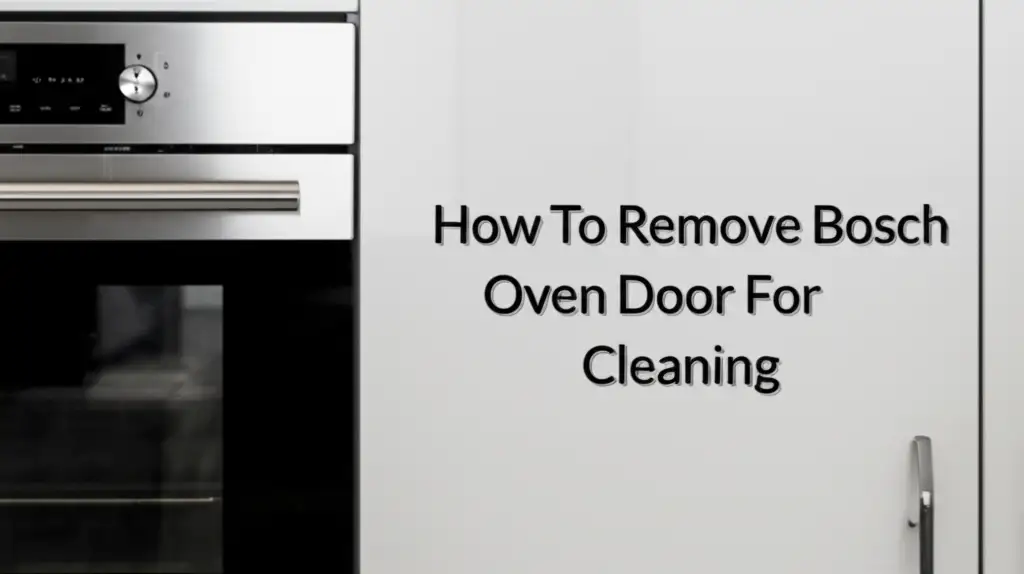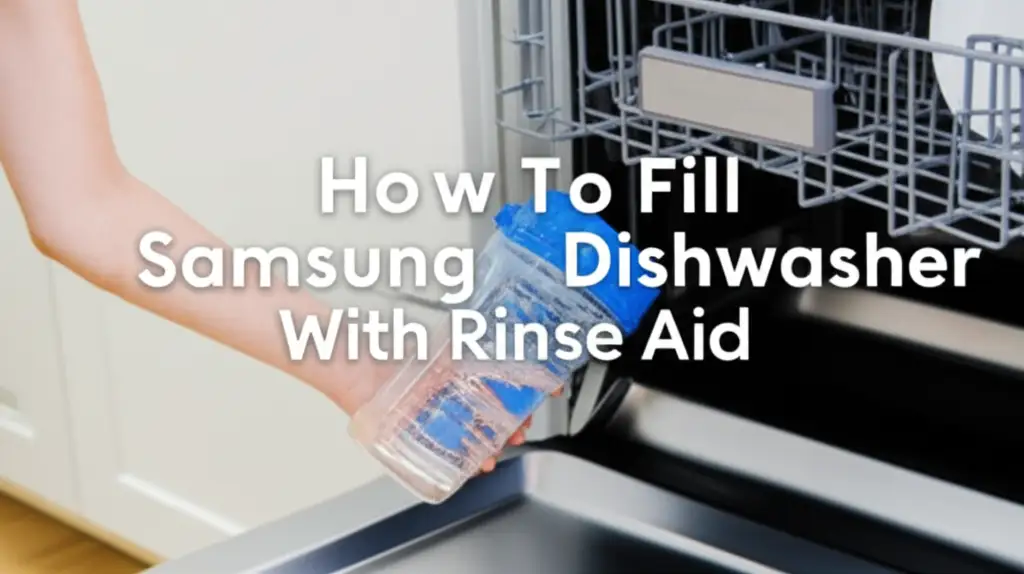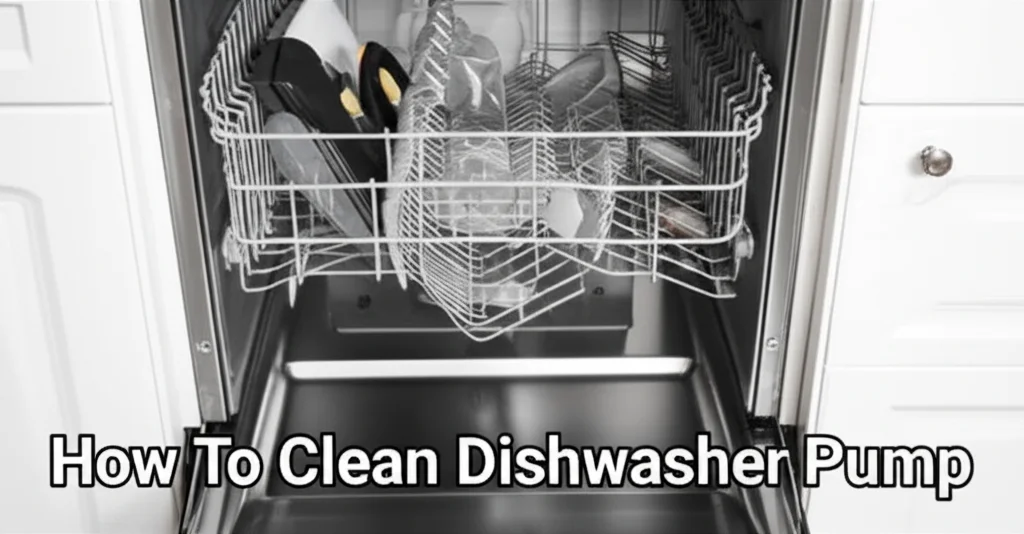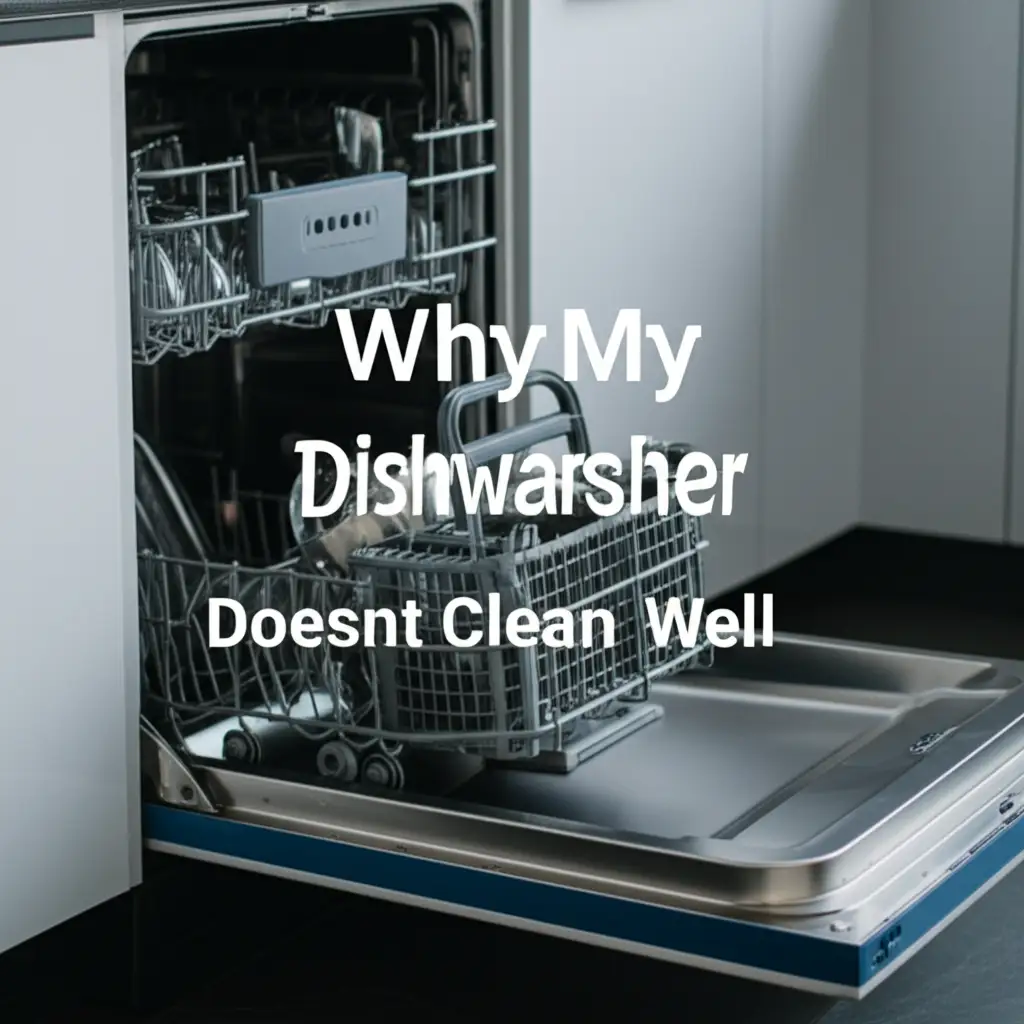· Katria Melrose · Appliance Maintenance · 15 min read
How To Remove Bosch Oven Door For Cleaning

How To Remove Bosch Oven Door For Cleaning
A clean oven makes cooking more enjoyable. Over time, grease and spills build up, especially on the oven door. Cleaning the oven door thoroughly can be difficult with it attached. Learning how to remove your Bosch oven door for cleaning makes the job much easier.
This guide helps you achieve a sparkling clean oven. We will walk you through each step. You will learn how to prepare your oven, safely remove the door, clean its components, and then reinstall it. We also cover troubleshooting tips and maintenance advice. Get ready to transform your Bosch oven.
Takeaway:
- Safely remove your Bosch oven door by following specific hinge latch instructions.
- Clean all door components, including glass panes, with appropriate cleaners.
- Reinstall the door carefully, ensuring hinges lock correctly into place.
To remove your Bosch oven door for cleaning, first open the door fully. Then, locate and flip up the small locking latches on each hinge. Next, close the door slowly until it rests on the latches. Finally, lift the door straight up and out from the hinge slots.
The Benefits of Removing Your Bosch Oven Door for Cleaning
Cleaning your oven is a chore many people dislike. The door often collects the most grime. Food splatters, grease, and baked-on residue stick to the glass and frame. Trying to clean these areas with the door still attached is often frustrating. You cannot reach all parts easily.
Removing the Bosch oven door offers many advantages. It allows you to access hidden spots. You can reach the inner glass panes. This helps you clean both sides of the glass effectively. A cleaner oven door improves visibility inside the oven. It also prevents smoke and odors from old food buildup.
A deep clean extends the life of your appliance. Regular cleaning stops dirt from hardening. This prevents damage to the oven’s surfaces. It also helps your oven work more efficiently. I find that a clean oven makes me want to cook more often. It feels good to have a sparkling kitchen.
Taking the door off also makes it safer to clean. You can lay the door flat on a protected surface. This gives you a stable workspace. You avoid awkward bending or reaching. This also lowers the risk of scratching the oven or yourself. The process might seem daunting at first, but it is quite simple once you know how.
Essential Safety Precautions Before You Start
Safety is important when working with appliances. Before you begin to remove your Bosch oven door, take a few moments for preparation. This ensures a smooth and safe cleaning process. My first rule is always to prioritize safety. You should too.
First, turn off the power to your oven. Find the circuit breaker that controls the kitchen appliances. Flip it to the “off” position. This prevents any accidental activation while you are working. It also protects you from electrical shocks. Never work on an appliance with live power.
Next, make sure the oven is completely cool. If you just used it, wait several hours. Oven interiors and doors retain heat for a long time. Touching a hot surface can cause severe burns. Use an oven thermometer if you are unsure. A cool oven is a safe oven to handle.
Prepare your workspace. Lay down old towels or a blanket on the floor. This protects both your floor and the oven door. The door can be heavy and might scratch surfaces if it falls. Choose an area with enough space to maneuver the door comfortably. Gather all your cleaning supplies beforehand.
Wear appropriate protective gear. Gloves protect your hands from cleaning chemicals. They also offer a better grip on the door. Safety glasses protect your eyes from splashes. Taking these simple steps makes the job much safer and easier.
Step-by-Step Guide: How to Remove a Bosch Oven Door
Removing your Bosch oven door is a straightforward process. Bosch designs their ovens with user convenience in mind. I remember the first time I tried this; it felt a bit intimidating. But following these steps makes it simple. You will gain confidence quickly.
Preparing the Oven Door for Removal
Start by opening your oven door fully. Pull it down until it is completely horizontal. You will see the hinges on both sides. These hinges have small locking mechanisms. They are usually small levers or clips.
Locate these hinge locking latches. They are typically found at the base of each hinge arm. Different Bosch models may have slightly different designs. Some might require you to push them, others to pull them. My oven has small clips you flip upwards.
Carefully flip up or push forward the locking latches on both hinges. Make sure both latches are fully engaged. This locks the hinges open. It prevents them from retracting when you lift the door. This step is crucial for safe door removal.
Lifting the Door Off Its Hinges
Once the latches are engaged, slowly lift the oven door upwards. Do not close the door at this stage. You are just checking that the latches hold the hinges in place. The door should feel secure in its fully open position.
Now, gently close the oven door about halfway. As you close it, the hinge arms will touch the engaged latches. The door will stop moving further down. This is the resting position for removal. It helps you lift the door correctly.
With the door in this halfway position, grip it firmly on both sides. Lift the door straight up and out of its hinge slots. The door is heavy, so lift with your legs, not your back. You might need a second person to help with this step. I always ask for help when lifting heavy objects.
Place the removed door on your prepared, protected surface. Make sure it is stable and won’t tip over. You are now ready for the deep cleaning. Remember to be gentle with the door.
Deep Cleaning Your Bosch Oven Door Components
With the Bosch oven door removed, you can begin the deep cleaning. This is where you address all the grime. A spotless door improves your oven’s appearance and function. I always feel a great sense of accomplishment after this step.
Cleaning the Outer Door and Frame
Start with the outer surfaces of the door. Use a non-abrasive cleaner for stainless steel or enamel. Wipe down the door frame and the exterior glass. A soft cloth or sponge works best. Avoid harsh scrubbers that can scratch the finish.
For stubborn grease, you might need a degreaser. Spray it on, let it sit for a few minutes, then wipe it clean. Always read the cleaner’s instructions. Rinse the surface with a damp cloth to remove any residue. Finish by drying the door with a clean, dry cloth for a streak-free shine.
Cleaning the Inner Glass Panes
Many Bosch oven doors have multiple glass panes. These panes often collect drips and splatters between them. This makes the oven look dirty even after regular cleaning. Removing the outer glass pane allows you to reach these inner surfaces.
- Locate Access Screws: Look for screws around the perimeter of the inner door panel. They are usually small Phillips head screws.
- Remove Screws: Use a screwdriver to carefully remove these screws. Keep them in a small container so you don’t lose them.
- Remove Outer Glass: Gently lift the outer glass pane away from the door frame. Be very careful; glass can be fragile. Place it on a soft, flat surface.
- Clean All Panes: Now you have access to all glass surfaces. Use a glass cleaner or a mixture of baking soda and water. Apply the mixture, let it sit, then scrub with a non-scratch pad. For tough stains, a plastic scraper can help.
- Rinse and Dry: Wipe the glass clean with a damp cloth. Then dry thoroughly with a lint-free cloth. Ensure no moisture remains between the panes.
For even more specific guidance on cleaning glass, you can refer to articles like How To Clean The Glass On Oven Door or How To Clean An Oven Door Window. These resources offer excellent tips for tackling tough glass stains. Clean all sides of each glass pane. This ensures clarity when you are done.
Cleaning the Hinges and Seals
Don’t forget the hinges and the door seal. Wipe down the hinges on the door itself. Use a damp cloth to clean off any grease. Avoid getting too much water inside the hinge mechanism. The door gasket or seal around the oven opening also needs attention.
Clean the seal with a damp cloth and mild soap. This helps maintain a good seal. A proper seal keeps heat inside the oven. It also prevents leaks. Make sure the gasket is not cracked or torn. If it is, consider replacing it for better oven performance.
Reinstalling Your Bosch Oven Door Safely
After thorough cleaning, it is time to put your Bosch oven door back on. This step is just as important as removal. Proper reinstallation ensures your oven functions correctly and safely. I always take my time with this part.
Aligning the Hinges
Hold the cleaned oven door firmly by its sides. Make sure the hinge arms are still in the open, locked position. The latches should be flipped up or forward. This is how you prepared them for removal. If they moved, reset them now.
Carefully align the hinge arms with the slots on the oven frame. The hinge arms should slide smoothly into the slots. You might need to wiggle the door slightly to get them to fit. Do not force the door. If it does not slide in easily, recheck your alignment.
Securing the Door
Once the hinge arms are fully seated in the slots, open the door completely. Pull it down to its horizontal position. The door should open freely. If it feels stiff or binds, the hinges are not correctly seated. Lift the door off again and try to re-insert it.
With the door fully open, locate the hinge locking latches again. They are still flipped up or forward from when you removed the door. Now, you need to push them back into their original, closed position. This unlocks the hinges. Ensure both latches click firmly into place. This is a crucial step for securing the door.
Testing the Door
Gently close the oven door. It should close smoothly and fully. There should be no gaps when the door is shut. Open and close the door a few times to test its operation. Feel for any resistance or unusual sounds.
Check the alignment of the door. It should sit flush with the oven frame. If the door seems crooked or does not close properly, the hinges may not be fully engaged. Repeat the reinstallation steps if needed. A correctly installed door ensures efficient cooking and energy use. Putting the door back correctly is as simple as installing a door on a Samsung oven, as detailed in How To Put Samsung Oven Door Back On, or other brands like LG or KitchenAid, which have similar reinstallation processes.
Common Issues and Troubleshooting During Door Removal
Even with clear instructions, sometimes things do not go as planned. It is normal to encounter small challenges. Knowing how to troubleshoot can save you time and frustration. I have run into a few of these myself.
Door Won’t Budge
If your Bosch oven door does not lift off the hinges, double-check the latches. Ensure both hinge locking latches are fully engaged. They must be completely flipped up or pushed forward. Sometimes they get stuck halfway. Use a flathead screwdriver to gently nudge them into place if needed.
Also, confirm the door is in the correct halfway closed position. The hinges must rest against the latches. If the door is too far open or too far closed, it won’t lift. Try adjusting its angle slightly. Lift straight up, without tilting the door.
Difficulty Reinstalling the Door
Putting the door back on can be tricky. The most common issue is hinge misalignment. The hinge arms must slide perfectly into the oven’s hinge slots. Do not force the door. Forcing it can damage the hinges or the oven frame.
If the door does not sit flush, remove it and try again. Ensure both hinges are inserted at the same time. You may need to tilt the door slightly to align both sides. Once the hinges are in, remember to push the locking latches back down. This secures the door. If you forget this step, the door will not close correctly.
Damaged Hinges or Latches
Sometimes, a hinge or latch might be broken. This can prevent proper removal or reinstallation. Inspect the hinges for any visible damage. Look for bent metal or broken plastic parts. If you suspect damage, do not force anything.
Contact Bosch customer service or a qualified appliance technician. They can advise on replacement parts or professional repair. Trying to fix damaged hinges yourself can cause further harm. Your oven might beep if the door is not closing properly, which relates to issues like those discussed in Why Does My Bosch Oven Beep When I Open The Door. This indicates a sensor issue or poor door seal.
Maintaining Your Bosch Oven for Lasting Cleanliness
Removing and cleaning your Bosch oven door is a great start. But regular maintenance keeps your oven pristine. Consistent small efforts prevent large cleaning tasks. I believe in proactive care for all my appliances.
Regular Spot Cleaning
Do not wait for significant buildup. Wipe up spills immediately after they happen. This prevents food from baking onto surfaces. Use a damp cloth and mild dish soap for fresh spills. This habit saves a lot of hard work later.
Wipe down the oven door and frame after each major cooking session. This includes the glass. A quick wipe prevents grease from hardening. This simple step keeps the door looking clean longer. It also reduces the frequency of deep cleans.
Oven Self-Cleaning Cycle (If Applicable)
Many Bosch ovens come with a self-cleaning feature. Use this cycle periodically if your oven has one. The self-cleaning cycle uses high heat to burn off food residue. Always follow your oven’s manual for instructions. Remove racks and any large debris before starting the cycle.
After the self-cleaning cycle finishes and the oven cools, wipe away the ash. This feature greatly reduces the need for manual scrubbing. Do not use chemical cleaners after a self-clean cycle. The oven is already very hot.
Use Oven Liners and Baking Sheets
To prevent spills, use oven liners or baking sheets. Place them on the rack below the food you are cooking. They catch drips and overflow. This protects the oven floor and door from messes. Liners are easy to clean or replace.
This small habit makes a big difference. It minimizes the amount of food that ends up on your oven’s interior. Less mess means less frequent deep cleaning. Protecting your oven while cooking helps maintain its cleanliness.
Professional Cleaning Advice
Sometimes, despite best efforts, you might need extra help. If your oven has extremely stubborn stains, consider professional cleaning products. There are many strong oven cleaners available. Always follow product instructions carefully. Ensure proper ventilation.
For very severe cases, or if you prefer not to clean it yourself, professional oven cleaning services exist. They have specialized tools and chemicals. They can restore a very dirty oven to near-new condition. Regular maintenance, though, can often prevent this need.
Frequently Asked Questions About Bosch Oven Door Removal
Q1: Is it safe to remove my Bosch oven door myself?
Yes, removing your Bosch oven door is safe if you follow proper instructions. Always ensure the oven is cool and the power is off. Use caution when handling the heavy door. Follow the hinge latch instructions carefully to prevent injury.
Q2: How often should I deep clean my Bosch oven door?
The frequency depends on your cooking habits. For heavy use, consider a deep clean every 3-6 months. For lighter use, once a year might be enough. Regular spot cleaning reduces the need for full door removal.
Q3: What cleaning products are safe for Bosch oven doors?
Use non-abrasive cleaners. Mild dish soap and warm water work for most surfaces. For glass, a glass cleaner or a baking soda paste is effective. Avoid harsh chemicals or metal scrubbers that can scratch the finish or damage seals.
Q4: What if my Bosch oven door won’t go back on?
If the door won’t reinstall, the hinges are likely misaligned. Ensure both hinge arms are fully extended and in the locked position. Carefully align them with the oven slots. Push them in simultaneously. Remember to release the hinge latches once the door is fully open on the oven.
Q5: Can I clean the oven door glass without removing the door?
You can clean the outermost glass without removing the door. However, to clean between the inner glass panes, you usually need to remove the door. Many Bosch models have multiple glass layers that collect grime between them. Removing the door allows access to these hidden areas.
Q6: Do all Bosch oven models have removable doors?
Most modern Bosch ovens feature removable doors. This design allows for easier cleaning and maintenance. However, older models or certain compact designs might not have this feature. Always consult your specific Bosch oven’s user manual to confirm if your model’s door is removable.
Conclusion
A clean oven is a happy oven. Learning how to remove your Bosch oven door for cleaning makes deep cleaning much simpler. This comprehensive guide has walked you through each step. You now know how to prepare safely, remove the door, clean every component, and reinstall it correctly.
Remember to prioritize safety by turning off power and allowing the oven to cool. Take your time with hinge latches and door alignment. Regular maintenance and spot cleaning will keep your Bosch oven door spotless for longer periods. Embrace these steps to enjoy a cleaner kitchen and better cooking experiences. Your Bosch oven deserves this care.
- Bosch oven cleaning
- oven door removal
- deep oven cleaning
- appliance care
- kitchen maintenance
- Bosch appliance





